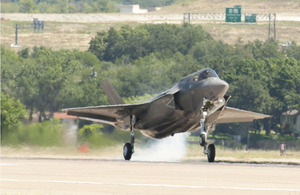UK takes delivery of first Lightning II fighter jet
The first of the UK's next generation stealth combat aircraft has today been handed over to the MOD.

The UK's new Lightning II aircraft, taken at Fort Worth, Texas, USA. The aircraft was piloted by RAF Squadron Leader Jim Schofield [Picture: Tom Harvey, via MOD]
At a ceremony in Fort Worth, Texas, Defence Secretary Philip Hammond formally accepted the first of the jets, which will be known as Lightning II.
The aircraft are short take-off and vertical landing (STOVL) F-35 Joint Strike Fighters and are manufactured by Lockheed Martin.
The UK is the first country outside the US to receive these aircraft, and Mr Hammond today announced that the MOD intends to order a fourth Lightning II aircraft next year to add to the three already on contract.
The RAF and Royal Navy will conduct flight trials of the jets which will operate from land bases and from the sea.
Lightning II will be operational from land-based airfields from 2018, when it will also commence flight trials off HMS Queen Elizabeth carrier. Mr Hammond announced that the jets are likely to be based at RAF Marham in Norfolk, but no decision has yet been made.
The UK will benefit from interoperability with the US Marine Corps which operates STOVL aircraft similar to the Lightning II.

Royal Navy Fleet Commander, Admiral Sir George Zambellas, third from left, Defence Secretary Philip Hammond, fourth from left, and the Chief of the Air Staff, Air Chief Marshal Sir Stephen Dalton, fourth from right, pose alongside trans-Atlantic colleagues and business partners at the F-35 Lightning II delivery ceremony in Fort Worth, Texas [Picture: Angel DelCueto, via MOD]
The multi-role jet features the latest stealth and intelligence, surveillance, target acquisition and reconnaissance (ISTAR) technology and represents the cutting-edge of combat aircraft design.
Fifteen per cent of Joint Strike Fighter work is carried out in the UK, and over 130 British companies contribute to the supply chain. It is worth over £1bn to UK industry each year and will support around 25,000 British jobs over the next 25 years.
After the acceptance ceremony, the Defence Secretary toured Lockheed Martin’s production plant with representatives of major UK subcontractors on the programme, including BAE Systems and Rolls-Royce.
Mr Hammond said:
This hugely capable combat aircraft is now officially British and in the hands of our expert pilots.
Highly skilled British aerospace workers are also playing a vital role in the delivery of Lightning II, with UK companies involved in 15 per cent of the production and 25,000 British jobs sustained as a result.
Having taken decisions on the final designs of our new aircraft carriers and balanced the MOD’s budget, we can now proceed confidently to regenerating our carrier strike capability with these cutting-edge stealth combat aircraft.
The Chief of the Air Staff, Air Chief Marshal Sir Stephen Dalton, said:
The delivery of the United Kingdom’s first Lightning II marks the beginning of a new era in our ability to project air power from the land or sea.
Alongside our increasingly capable combat-proven multi-role Typhoons, the Lightnings provide an additional complementary capability to our growing Combat-ISTAR force.
Royal Navy Fleet Commander, Admiral Sir George Zambellas, said:
Jets at sea offer unmatched persistence and can guarantee the delivery of air power around the globe.
With the advent of Lightning II, UK Defence has its opportunity to maximise the utility of our carriers and this extraordinarily capable aircraft through a range of sea and land basing options. The result will be a strategic capability which will deliver for many decades to come.